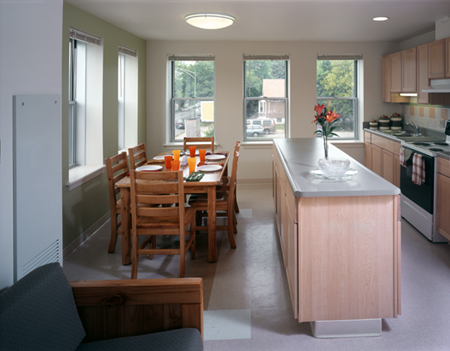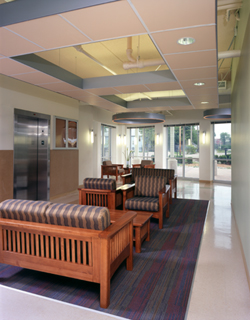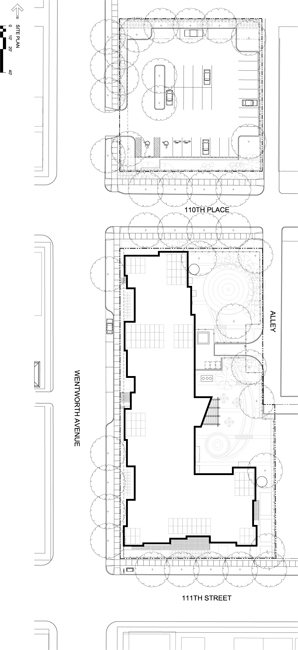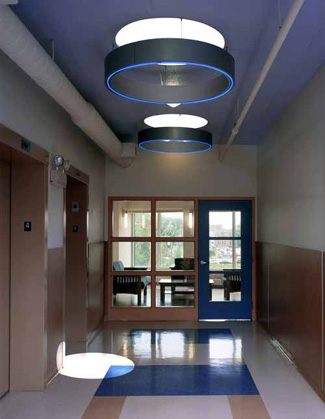 |
 |
| Project
Summary: Wentworth Commons
OWNER/DEVELOPER
Mercy Housing Lakefront
ARCHITECT
Harley Ellis Devereaux
LANDSCAPE
ARCHITECT
Site Group Design
CONTRACTORS
Linn Mathes PROPERTY
MANAGEMENT
Mercy Housing Lakefront
| FUNDERS: |
TYPE: |
| 1st Mortgage-Chicago Dept. of Housing Community Development Block Grant |
Grant |
| Federal Home Loan Bank |
Loan |
| Illinois Department of Commerce & Economic Opportunities |
Grant |
| HUD Supportive Housing Program Capital |
Grant |
| Sale of Tax Credits |
|
| Illinois Clean Energy Community Foundation |
Grant |
| ComEd |
Grant |
| Enterprise Green Communities Initiative |
Grant |
DEVELOPMENT
TYPE:
Rental apartments with onsite Supportive Services
RESIDENT
PROFILE:
Chicago Market MFI=$47,186 One-third of 80% MFI=$12,457. Based on affordability criteria, 61% of units qualify. However, each tenant pays no more than one-third of their income toward rent. Additionally, 20 units are subsidized by Shelter Plus Care funds from HUD
DENSITY: 46 units per acre
DEVELOPMENT
PROFILE
| Type |
#/Units |
Size
(sf) |
Rent |
| Studio |
24 |
320 |
$400 - $623 |
| 2 BR |
9 |
800 |
$600 - $891 |
| 3 BR |
15 |
1100 |
$1114 |
| 4 BR |
3 |
1400 |
$1247 |
| Total |
51
|
|
|
Community facilities: Community Room, FamilyResource Center, shared living rooms on each floor
Parking: 31
Total site area:49,465 sf |
CONSTRUCTION
TYPE
Four storey
exterior masonry bearing walls, interior stell framing at corridor wall. Concrete plank floors and roof.
DEVELOPMENT
COSTS:
Land cost: NA (donated by city of Chicago); Constr. costs:
$10,737,810; Other costs: $3,001,132;Total
development costs: $13,738,942;
$269,391 per unit. Completed in October 2005.
|
|
|
Wentworth Commons- Chicago, IL
Green Features

The Wentworth Commons Residence provides 51 affordable apartments for recently homeless families and individuals in the Roseland neighborhood of Chicago. The 65,800 s.f., four story building includes a housing program on the upper floors and supportive services on the ground floor. Apartments range in size from studios to four bedrooms and are blended throughout the building to create a sense of community. Supportive services include a family resource center with community space, case management areas, employment training, and leadership development.

 Providing more than merely shelter, Wentworth Commons offers a healthy environment for its residents, greater long term affordability due to energy efficiency measures, and a facility that minimally impacts the City infrastructure. Wentworth provides sustainable supportive housing as a direct response to the needs of a low-income, minority community that has lost housing, businesses, and other economic resources. Providing more than merely shelter, Wentworth Commons offers a healthy environment for its residents, greater long term affordability due to energy efficiency measures, and a facility that minimally impacts the City infrastructure. Wentworth provides sustainable supportive housing as a direct response to the needs of a low-income, minority community that has lost housing, businesses, and other economic resources.
Wentworth’s development by Mercy Housing Lakefront was supported by the community of Roseland from the very beginning, as demonstrated by an invitation from the local Alderman to develop the site. This was based on Mercy Housing’s successful conversion of a neighborhood nursing home into a Single Room Occupancy facility.
Incorporating sustainable design was an early goal for the project. This lead to a planning process structured around sustainability within the multi-disciplinary design team. During schematic design an eco-charrette was held with all team members in attendance, including the general contractor. In all of the subsequent coordination meetings the LEED Rating System remained a focal point throughout the design development and construction document phases.
 Wentworth’s site, a former brownfield, was donated by the city of Chicago. The site faces commercial uses along 111th Street and residential uses along 110 th Place and Wentworth Avenue. The L-shaped building footprint establishes a strong street edge, while providing a secure backyard garden, sheltered from the bustle of the two main streets. The Wentworth’s parking area incorporates a light colored paving system and the building’s roof is highly reflective. These measures help to reduce the project’s contribution to the urban heat island effect. The Wentworth is served by two major bus lines, one of which provides connections to a commuter rail station one mile east of the building. The project is pedestrian and bicycle friendly, with a permanent bike storage room on the ground floor for resident and staff use.
Wentworth’s site, a former brownfield, was donated by the city of Chicago. The site faces commercial uses along 111th Street and residential uses along 110 th Place and Wentworth Avenue. The L-shaped building footprint establishes a strong street edge, while providing a secure backyard garden, sheltered from the bustle of the two main streets. The Wentworth’s parking area incorporates a light colored paving system and the building’s roof is highly reflective. These measures help to reduce the project’s contribution to the urban heat island effect. The Wentworth is served by two major bus lines, one of which provides connections to a commuter rail station one mile east of the building. The project is pedestrian and bicycle friendly, with a permanent bike storage room on the ground floor for resident and staff use.
The entry sequence at the ground floor provides a connection to the exterior and fosters resident/visitor education: As one enters through the security vestibule into the main lobby, glazing allows a visual connection through the building to the natural environment beyond. Programmed exterior spaces work in concert with the architecture, providing seating areas under a trellis and open space for children’s play in the garden. Bridge platforms cross over a planted bio-swale where exposed filtering devices not only manage site water, but illustrate the cycle of water collection and conveyance. As the building occupants are mostly families and youth, these features will be used as an educational tool, integrating and exposing systems and cycles rarely experienced at this scale.
The community surrounding the Wentworth site has been blighted for many years, prompting the project designers to establish a new aesthetic rather than draw from the immediate context. The resulting architecture expresses sustainability most notably in the 33kWh photovoltaic system supported by exposed trusses at the roof line, and the use of earth tones for the exterior masonry and the interior finishes. Twenty-six percent of the building products were manufactured within a 500 mile radius of the project, including all the exterior masonry. Rapidly renewable materials included cork flooring in the community spaces and wheatboard wainscot in all of the corridors. The wainscot also serves to improve the durability of the corridor walls. The Astra-glaze product that gives the exterior its lively color was in part selected because of its graffiti resistant properties. The building has permanent recycling rooms on each floor, and residents are encouraged to sort, newspapers, plastic, aluminum and glass.

Asthma and other upper respiratory diseases are often an unfortunate characteristic of the "at-risk" population of Wentworth and this is further exacerbated by little or no access to proper healthcare. As such, improved Indoor Air Quality was sought through the specification of low emitting paints, sealants and adhesives.
Wentworth’s mechanical system is designed to be 28% more efficient than the Chicago Energy Conservation Code (earning 4 points in the LEED rating system). This will result in an annual energy savings of $20,000 to $25,000 based on year 2005 gas prices . Daylighting is maximized most notably in the double loaded corridors where borrowed light from the shared living rooms on each floor enters deep into the elevator lobbies. Additionally skylights were incorporated at the top floor.
Wentworth was commissioned in compliance with LEED and a Building Automated System was specified to help maintain the systems over the long haul. The owner is also now seeking funding to further monitor this facility and compare it to their other facilities, where lesser levels of sustainability were incorporated.
Lessons Learned from the architect -
-
When sustainability is a goal, the importance of incorporating this as early as possible in the design process cannot be overstated. In the case of Wentworth, sustainability was identified during the feasibility study and we believe that this early commitment contributed to its success as a “green” building.
- At the end of the day we believe that good architects, by nature always want to improve on their next design. The fact that “constantly learning” is a part of the field is what draws many of us to it. In the case of the team for Wentworth, the developer/owner had that same attitude and this created a great synergy for taking on the budgetary challenges. We can easily point to aspects of Wentworth and say what we would do better next time, but for us there is a larger mission. And that mission is about changing the definition of affordable housing and the funding mechanisms for providing it.
- The fundamental flaw in today’s definition of affordable is that it only applies to initial building cost. This definition needs to expand to include long term operating cost. Payback has to be part of the formula. If you have read this far then certainly the budget struggles for this type of real world project are all too apparent. Despite not having the economic luxuries that demonstration projects have, Wentworth joins a handful of other supportive housing projects (most of which are finding their way onto this website!) that are setting an example and raising the standard for this type of shelter to include sustainability. – Susan F. King, AIA, LEED AP, Architect for Wentworth Commons
Jury Comments:
-
The roof PV's are dynamic
-
This is an eye catching, colorful project that meets LEED requirements and is 100% affordable
-
Nice site design, a good example of low impact development.
|



 Wentworth’s site, a former brownfield, was donated by the city of Chicago. The site faces commercial uses along 111th Street and residential uses along 110 th Place and Wentworth Avenue. The L-shaped building footprint establishes a strong street edge, while providing a secure backyard garden, sheltered from the bustle of the two main streets. The Wentworth’s parking area incorporates a light colored paving system and the building’s roof is highly reflective. These measures help to reduce the project’s contribution to the urban heat island effect. The Wentworth is served by two major bus lines, one of which provides connections to a commuter rail station one mile east of the building. The project is pedestrian and bicycle friendly, with a permanent bike storage room on the ground floor for resident and staff use.
Wentworth’s site, a former brownfield, was donated by the city of Chicago. The site faces commercial uses along 111th Street and residential uses along 110 th Place and Wentworth Avenue. The L-shaped building footprint establishes a strong street edge, while providing a secure backyard garden, sheltered from the bustle of the two main streets. The Wentworth’s parking area incorporates a light colored paving system and the building’s roof is highly reflective. These measures help to reduce the project’s contribution to the urban heat island effect. The Wentworth is served by two major bus lines, one of which provides connections to a commuter rail station one mile east of the building. The project is pedestrian and bicycle friendly, with a permanent bike storage room on the ground floor for resident and staff use.
